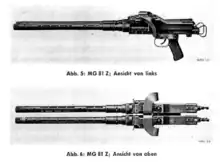| MG 81 | |
|---|---|
 MG 81 (upper) and MG 81Z (in box) | |
| Type | Machine gun |
| Place of origin | Nazi Germany |
| Service history | |
| Used by | Nazi Germany |
| Wars | World War II |
| Production history | |
| Variants | MG 81Z |
| Specifications | |
| Mass | 6.5 kg (14.33 lb) |
| Length | 965 mm (38.0 in) (with flash hider) |
| Barrel length | 475 mm (18.7 in) |
| Cartridge | 7.92×57mm Mauser |
| Caliber | 7,9 (7,92+0,04)[1] |
| Action | Recoil-operated, gas assisted, open-bolt |
| Rate of fire | 1,400–1,600 rounds/min |
| Muzzle velocity | 705 m/s (2,310 ft/s) (sS ball ammunition) |
| Feed system | Belt-fed |
The MG 81 is a German belt fed 7.92×57mm Mauser machine gun which was used in flexible installations in World War II Luftwaffe aircraft, in which capacity it replaced the older drum magazine-fed MG 15.
The MG 81 was developed by Mauser as a derivative of their successful MG 34 general-purpose machine gun. Development focus was to reduce production cost and time and to optimize the machine gun for use in aircraft. Developed in 1938/1939, it was in production from 1940 to 1945.
A special twin-mount MG 81Z (the Z suffix stands for Zwilling, meaning "twin") was introduced in 1942. It paired up two of the weapons on one mount to provide even more firepower with a maximum cyclic rate of fire of 3,200 rounds per minute without requiring much more space than a standard machine gun. Towards the end of the war many specimens were delivered to the army and equipped for use in ground battles with shoulder rest and bipod.

Applications
The MG 81Z was found in many unique installations in Luftwaffe combat aircraft, such as a pair of MG 81Z (for a total of four guns) installed in the hollow tail cone of the Dornier Do 217 K-2. Designated R19 (R for Rüstsatz) as a factory designed field conversion/upgrade kit, it allowed the pilot of the Do 217 to shoot at pursuers.
Another application was the Gießkanne (Watering can), an externally mounted pod with three gun pairs, making a total of six guns and their ammunition. Able to fire at a cyclic rate of 9,000 rounds per minute, this was attached to Junkers Ju 87 or Ju 88 in an underwing mount and used to strafe ground targets.[2]
Specifications
- MG 81
- Weight: 6.5 kg (14 lb)
- Length: 915 mm (36.0 in) (965 mm (38.0 in) with flash hider)
- Muzzle velocity: 705 m/s (2,310 ft/s) (sS ball ammunition), 755 m/s (2,480 ft/s), 785 m/s (2,580 ft/s) or 790 m/s (2,600 ft/s), depending on ammo type
- Rate of fire: 1,400–1,600 rpm (sS ball ammunition)
- Rate of fire: 1,700–1,800 rpm[3]
- Rate of fire: 800 rpm (coaxial mount)[4]
- MG 81Z
- Weight: 12.9 kg (28.44 lb)
- Length: 915 mm (965& mm with flash hider)
- Muzzle velocity: 705 m/s (2,310 ft/s) (sS ball ammunition), 755 m/s (2,480 ft/s), 785 m/s (2,580 ft/s) or 790 m/s (2,600 ft/s), depending on ammo type
- Rate of fire: 2,800–3,200 rpm (sS ball ammunition)
- Rate of fire: 3,400–3,600 rpm[5]
See also
References
- ↑ "Maschinengewehr MG 81 MG 81 Z". www.deutscheluftwaffe.com. p. 9. Archived from the original on 29 January 2019. Retrieved 12 January 2022.
- ↑ Gordon L Rottman (20 October 2013). SNAFU Situation Normal All F***ed Up: Sailor, Airman, and Soldier Slang of World War II. Osprey Publishing. p. 256. ISBN 978-1-78200-175-1.
- ↑ "Maschinengewehr MG 81 MG 81 Z". www.deutscheluftwaffe.com. Archived from the original on 29 January 2019. Retrieved 12 January 2022.
- ↑ "Maschinengewehr MG 81 MG 81 Z". www.deutscheluftwaffe.com. Archived from the original on 29 January 2019. Retrieved 12 January 2022.
- ↑ "Maschinengewehr MG 81 MG 81 Z". www.deutscheluftwaffe.com. Archived from the original on 29 January 2019. Retrieved 12 January 2022.